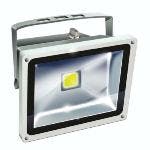Both floodlights have the same performance in that they both have a radiant power of 5W. Note that watts are the radiometric units of radiant flux while the more commonly given specification of lumens are photometric units of luminous flux. The relationship between watts and lumens is not simple and beyond the scope of this discussion. The point here is that both floodlights look equally bright to the human eye and have roughly similar visible light spectrums.
++++++
This article was published in the November/December 2010 issue of LEDs Magazine. To read the full version of this article, please visit our magazine page, where you can download FREE electronic PDF versions of all issues of LEDs Magazine. You can also request a print copy of LEDs Magazine (available by paid subscription) and sign up for our free weekly email newsletter.






